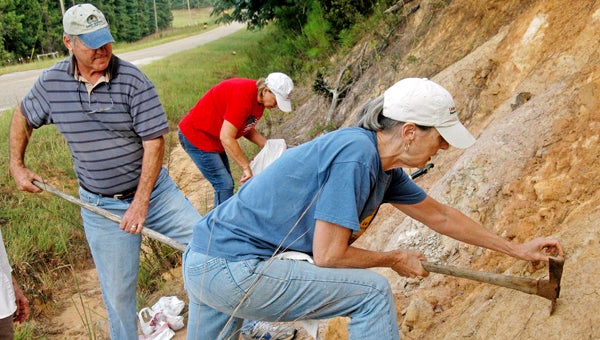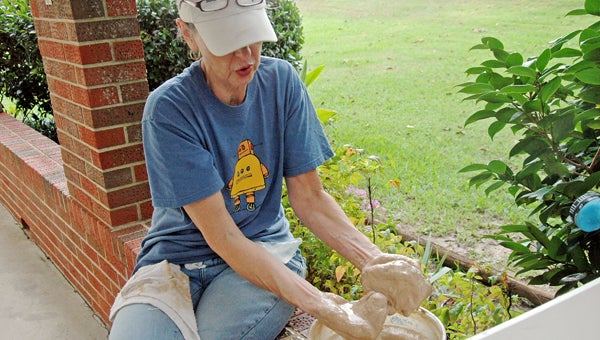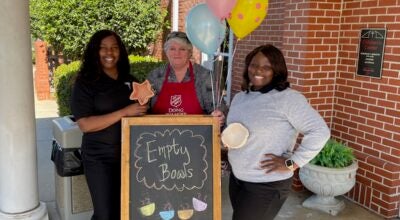THE CLAY BUDDIES: Potters mine their own clay for ceramics
Published 3:00 am Saturday, August 15, 2015

The Pottersville Potters, better known as the clay buddies, mine clay for their pottery from embankments along dirt roads all around Pike County. The clay is processed and then molded into pottery. They were out early on a hot August morning search for a particular vein of clay. Scott Swindall, center, Jeannie Swindall, back, and Marian Parker, front, mine for clay at a clay bank.
MESSENGER PHOTO/JAINE TREADWELL
- Marian Parker uses water to soften the clay. Parker, facilitator at the Colley Senior Complex’s Pottery Studio, recently won the Instructables Clay Contest, which was a worldwide website competition. Her winning pot will be on display, along with the creations of 14 potters who work at the Pottery Studio, from 10 a.m. until 2 p.m. Wednesday at 713 Elm St. The public is invited. MESSENGER PHOTO/JAINE TREADWELL
The sun was completing its peek over the horizon. The birds were singing, but little else was moving on the already hot, sultry August morning.
The miners quietly shed their shoes and pulled on their rubber boots. One by one, they grabbed shovels, picks and buckets and trudged up the road where clay was to be mined.
The group could be called the Pottersville Potters, but not all of them are from the Shellhorn area, which was called Pottersville because of the pottery operation there before the Civil War.
So, they are simply called “the clay buddies” and are led by the award-winning potter, Marian Parker who lives in Ansley, which is just up the road from Shellhorn.
On this particular and exceptionally mucky August morning, the clay buddies were on a clay mining expedition with expectations that the “fertile” bank would give over enough clay of different colors and grades for them to make pots into the New Year.
In June, Parker won first place in the Instructables Clay Contest with her found clay pottery. And, the clay she “found” and minded and molded was from in and around old Pottersville.
Instructables is a website specializing in user-created and uploaded do-it-yourself projects, which other users can comment on and rate for quality.
Parker is no stranger to Instructables, having competed successfully in the pimp, sweet potato and hand painted contests. She pimped the armrest of her 350-Z, fried sweet potatoes and swirled a sign for the roadside.
Even though she enjoyed participating in those contests, the clay contest was the one that she really put her heart into and sunk her hands into.
“I love working with clay,” Parker said. “Once I get my hand in the mud, I’m as happy and content as anyone could be. I lose myself. I can forget about the things of the world and just find joy in working the clay. It’s as if I never want to stop.”
And, as it often is, those who are passionate about their hobbies and/or their artistic talents, they want to share them.
And, that was Parker’s first thought when she won the Instructables clay contest. She would share the spoils of victory with her club buddies who mine clay with her and with those at the Colley Senior Complex Pottery Studio where she is a facilitator.
As first place winner in the clay contest, Parker won a table top electric wheel, a banding wheel, needle and tools all of which she will share. The Instructables Robot T-shirt, she, laughingly said, will keep for herself.
“I was excited to win the Instructables clay contest because I won, not for the pottery but for the process,” Parker said. “Making pottery is a creative process but, when you go out and actually mine the clay for your pottery, that’s a bit out of the ordinary and so rewarding.”
Parker’s clay mining buddies, Judy Baxter and Scott and Jeannie Swindall, are also passionate about working with clay and are up and ready to go on any mining expedition.
“Judy has been working with clay for about 12 years and is a very good potter,” Parker said. “She’s creative and inventive and has developed her own style, which is something I have yet to do.”
The Swindalls have been working with clay, seriously, for about a year and Parker said they both do beautiful and innovative work.
“We have outstanding potters who work at the Pottery Studio, and I’m so excited about having their work on display at Open House on Wednesday,” Parker said. “They all seem interested in mining their own clay and, hopefully, before long they’ll seek out clay banks and get involved in the process of found clay pottery.”
Parker said clay is abundant, but some areas are richer than others.
“I happen to live in an area where we have some really good veins,” she said. “We mine clay from banks where dirt roads have been cut and graded, revealing high banks that clearly show the clay veins. We like to dig deep because clay is usually better way down there.”
The clay buddies use shovels, pick axes and even spoons to dig out the clay.
“You can see the different veins in the clay and you can dig the clay you want,” Parker said. “Some potters would rather have clay with a good bit of sand in it; others want as little sand as possible. The amount of sand determines the texture so it’s a preference thing.”
Once the clay is mined, it is collected in plastic bags or buckets to take home. Then, there’s more fun to be had.
“What you do next depends on the hardness of the clay and your preference in the process,” Parker said. “Scott likes to pulverize his clay. I’d rather break mine into clumps. Either way, the clay has to be softened in water. It takes my clay longer to get soft and pliable than it does Scott’s, for obvious reasons.
As the water softens the clay, the sand sifts from the clay and sinks to the bottom, eventually; three layers are formed, sand, clay and water on top.
“Then you are ready to pour the water off,” Parker said. “As you pour it off, you have to watch for sand. As soon as you see sand, stop pouring. You don’t want sand in the clay unless you really want it there.”
Parker said the clay is “worked” much like kneading dough until it is the desired consistency. Then you place it in a plastic bag until its ready to be molded into a piece of found-clay pottery.
“Of course, it’s much easier and a lot less time consuming to purchase clay, and we do that, too,” she said. “But there’s nothing as satisfying as a piece of pottery made from clay you mined, processed and molded. It’s like you gave birth to it.”




